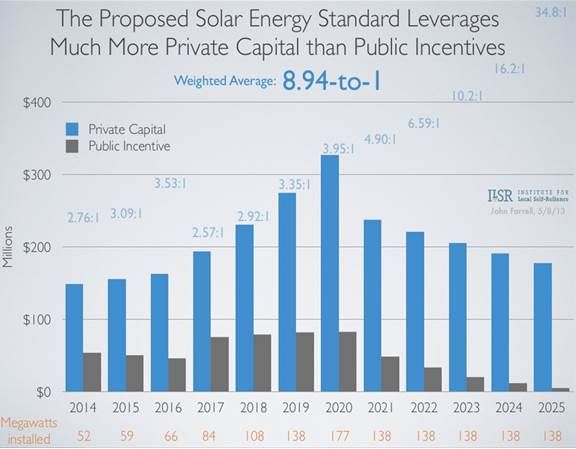The Minnesota legislature just approved a solar carve-out in the state’s Renewable Energy Standard expected to drive at least 450 megawatts of solar growth over the next seven years.
The new law requires Minnesota’s investor-owned utilities to obtain 1.5 percent of their power from solar energy by 2020. Of that, 20 percent must be from distributed solar systems of less than 20 kilowatts.
To drive solar growth, the law creates a five-year, $5 million per year fund that will pay performance-based incentives for ten years to system purchasers. The fund will come from payments by Xcel Energy (NYSE:XEL) of $500,000 per cask of spent nuclear fuel that it stores in Minnesota.
In answer to opponents of the solar standard, Institute for Local Self-Reliance State and Communities Energy Program Director John Farrell, one of the leaders in the drive for the new law, created a set of eight slides to illustrate its value. Below are three of his favorites and his thoughts about them.

“The first line for opponents of the solar standard bill is ‘Solar is expensive and it is going to cost a lot of money -- and why does it need incentives?’ so it’s important to tell the whole story,” Farrell explained. “This is an investment. For every dollar of public money put in, Minnesota will get an enormous return in private capital. It is, essentially, private capital building power plants for the public utilities. That’s a really great deal, especially when it also accomplishes environmental and economic goals.”
The solar standard will create about 1,400 installation jobs and about another 100 for operations and maintenance, Farrell said. Because the solar standard law includes performance-based incentives for ‘Made in Minnesota’ solar modules, about 20 percent of the new solar will likely be sourced from in-state manufacturers and the affiliated supply chain, Farrell added. He expects that to produce about 400 direct new jobs. That would likely produce about 2,700 indirect jobs associated with making components and providing services.

Solar’s availability at peak demand times puts it in direct competition with fast-ramp natural gas plants, Farrell pointed out. The California Energy Commission’s cost estimate for building simple-cycle, spinning-reserve, gas-fired facilities like those Xcel would need to meet peak demand is between $0.28 per kilowatt-hour and $0.65 per kilowatt-hour, Farrell said. The cost of rooftop solar in Minnesota is $0.18 per kilowatt-hour.
“The reason solar advocates pushed for a lot of distributed solar in the bill,” Farrell explained, “is because geographic distribution reduces solar’s minute-by-minute variability, making it more effective as a peak demand resource.” In addition, he added, “peak demand rises when the sun is shining. There is a high correlation in Minnesota between when the sun is shining and when there is an episode of peaking demand.”

“My favorite [slide] is the one about rapidly rising retail electricity prices,” Farrell said. “The utilities always talk about how solar is expensive and therefore rates are going to go up. My answer to the utilities is, rates are going up and it is your fault.”
Minnesota utilities have been raising rates at 4 percent per year for a decade, Farrell said. Solar will hit parity and be competitive by 2020, when this solar standard ends.
“A key part of the story,” Farrell said, “is that energy prices are not fixed. When we talk about changing the way we get energy, we are talking about a system that is constantly in motion, and generally that motion is upward price shifts. Solar fits in incredibly well because once the investment is made, the fuel cost is zero, forever."



